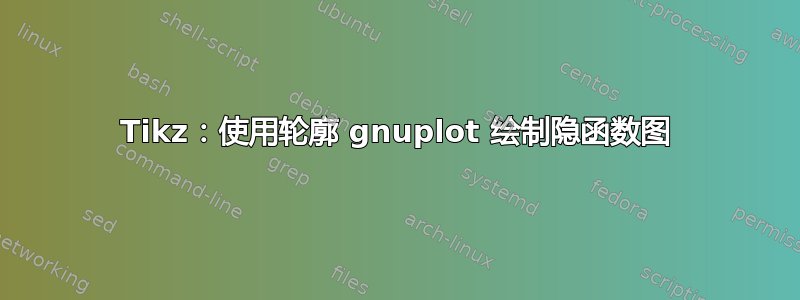
我尝试绘制一个隐式函数。我一直收到相同的错误消息:“未定义变量:设置”。
提前致谢。
\documentclass[border=5mm]{standalone}
\usepackage{pgfplots}
\usetikzlibrary{pgfplots.fillbetween}
\pgfplotsset{compat=newest}
\begin{document}
\begin{tikzpicture}
\begin{axis}[
title={Implicit Function Plot},
xlabel={$x$},
ylabel={$y$},
xmin=0, xmax=50,
ymin=0, ymax=50,
view={0}{90}, %
]
\addplot3[
thick,
contour gnuplot={levels={0}, labels=false}, % Adjust 'levels' as needed
samples=50, % Increase for higher resolution
samples y=50, % Explicitly defining samples y for clarity
domain=0:50,
domain y=0:50,
]
gnuplot {
set contour base;
set cntrparam levels discrete 0;
unset surface;
set view map;
splot -1/2*(x+y)**(-1/2)*x + 100 - (x+y)**(1/2) - 2*x;
};
\end{axis}
\end{tikzpicture}
\end{document}
答案1
在图中,我们可以看到f(x, y) = x/(2\sqrt{x +y}) +\sqrt{x +y} +2x与值 20 对应的函数的水平曲线。请注意,提问者的目标是表示 100 的水平曲线。
该解决方案基于一些计算,这些计算得出y作为函数的结果x(主要是求解二次方程)。当然,存在一个正性条件,它给出了的定义域x。绘图基于 TikZ 而不是 pgfplots。我不知道如何使命令contour起作用。
所绘制的函数被命名tmpM并按tmpP其形式引入;它们绘制在两个区间的并集上,这两个区间的边界由函数计算xLIni(即左区间的初始 x),......
在下面的代码中,有一个设置为 10 的变量;它对应于级别曲线的\a值。2*\a
评论。所涉及的数字很快就会变得太大。因此,必须全局修改单位(请参阅[x=6.7pt, y=.1pt])。
代码
\documentclass[11pt, margin=10pt]{standalone}
\usepackage{tikz}
\usetikzlibrary{math}
\begin{document}
\tikzmath{%
function xLIni(\c) {%
return {\c -2*\c};
};
function xLEnd(\c) {%
return {(2*\c +1/2 -pow(2*\c +1/4, .5))/2};
};
function xRIni(\c) {%
return {(2*\c +1/2 +pow(2*\c +1/4, .5))/2};
};
function xREnd(\c) {%
return {\c +2*\c};
};
function tmpM(\t, \c) {%
\tmp = (\t -\c)*(\t -\c) -\t/2;
return {2*\tmp -\t/2 -2*(\t -\c)*pow(\tmp, .5)};
};
function tmpP(\t, \c) {%
\tmp = (\t -\c)*(\t -\c) -\t/2;
return {2*\tmp -\t/2 +2*(\t -\c)*pow(\tmp, .5)};
};
}
\begin{tikzpicture}[x=6.7pt, y=.1pt,
evaluate={\a = 10; \b = int(\a*\a); \cst = int(2*\a);}]
\draw[->] ({xLIni(\a) -1}, 0) -- ({xREnd(\a) +1}, 0) node[above] {$x$};
\draw[->] (0, -.2) -- (0, {1.7*xREnd(\a)*xREnd(\a)}) node[left] {$y$};
\draw (\a, 0) -- +(0, 20) -- +(0, -20) node[below] {$\a$};
\draw (0, \b) -- +(.3, 0) -- +(-.3, 0) node[left] {$\b$};
\begin{scope}[every path/.style={%
blue, very thick, variable=\t, samples=100
}]
\draw[domain={xLIni(\a)}:{xLEnd(\a)}] plot (\t, {tmpM(\t, \a)});
\draw[domain={xLIni(\a)}:{xLEnd(\a)}] plot (\t, {tmpP(\t, \a)});
\draw[domain={xRIni(\a)+.05}:{xREnd(\a)}] plot (\t, {tmpP(\t, \a)});
\draw[domain={xRIni(\a)+.05}:{xREnd(\a)}] plot (\t, {tmpM(\t, \a)});
\end{scope}
\end{tikzpicture}
\end{document}
答案2
如果您想使用该gnuplot set语法,您必须使用该raw gnuplot选项来调用它。
除非你真的需要 rawgnuplot来做 不支持的事情pgfplots,否则我建议使用gnuplot内部函数pgfplots,如下所示。请注意,要绘制的函数必须是在pgfplots数学语法中,即您需要使用^而不是**。
编辑:Gnuplot 需要write18启用(外部命令)。使用 进行编译pdflatex --shell-escape file.tex。
\documentclass[border=5mm]{standalone}
\usepackage{pgfplots}
\usetikzlibrary{pgfplots.fillbetween}
\pgfplotsset{compat=newest}
\begin{document}
\begin{tikzpicture}
\begin{axis}[
title={Implicit Function Plot},
xlabel={$x$},
ylabel={$y$},
xmin=0, xmax=50,
ymin=0, ymax=50,
view={0}{90}, %
]
\addplot3[
thick,
contour gnuplot={levels={0,10,20,30}, labels=false},
samples=100,
samples y=100,
domain=0:50,
domain y=0:50,
]{-1/2*(x+y)^(-1/2)*x + 100 - (x+y)^(1/2) - 2*x};
\end{axis}
\end{tikzpicture}
\end{document}
您还可以使用contour lua来完全绕过gnuplot编译,而使用lualatex。有关pgfplots等高线图的更多详细信息,请参阅手册pgfplots。



